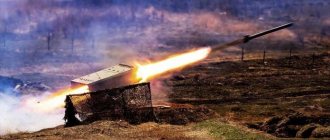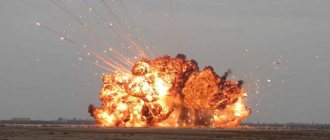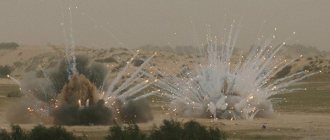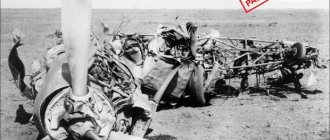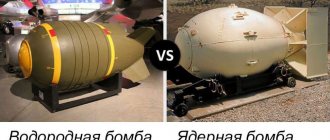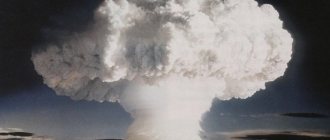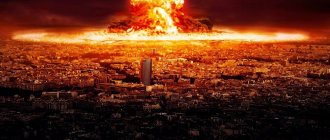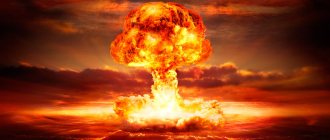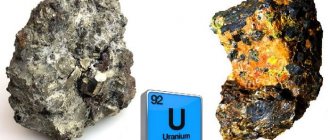On August 12, 1953, the first Soviet hydrogen bomb was tested at the Semipalatinsk test site.
And on January 16, 1963, at the height of the Cold War, Nikita Khrushchev told the world that the Soviet Union had new weapons of mass destruction in its arsenal. A year and a half earlier, the most powerful hydrogen bomb explosion in the world was carried out in the USSR - a charge with a capacity of over 50 megatons was detonated on Novaya Zemlya. In many ways, it was this statement by the Soviet leader that made the world realize the threat of further escalation of the nuclear arms race: already on August 5, 1963, an agreement was signed in Moscow banning nuclear weapons tests in the atmosphere, outer space and under water.
History of creation
Article on the topic
Creator of the “peaceful” atom. Kurchatov invented the bomb to avoid war. The theoretical possibility of obtaining energy by thermonuclear fusion was known even before World War II, but it was the war and the subsequent arms race that raised the question of creating a technical device for the practical creation of this reaction. It is known that in Germany in 1944, work was carried out to initiate thermonuclear fusion by compressing nuclear fuel using charges of conventional explosives - but they were not successful, since it was not possible to obtain the required temperatures and pressures. The USA and the USSR have been developing thermonuclear weapons since the 40s, almost simultaneously testing the first thermonuclear devices in the early 50s. In 1952, the United States exploded a charge with a yield of 10.4 megatons on the Eniwetak Atoll (which is 450 times more powerful than the bomb dropped on Nagasaki), and in 1953, the USSR tested a device with a yield of 400 kilotons.
The designs of the first thermonuclear devices were poorly suited for actual combat use. For example, the device tested by the United States in 1952 was a ground-based structure the height of a 2-story building and weighing over 80 tons. Liquid thermonuclear fuel was stored in it using a huge refrigeration unit. Therefore, in the future, serial production of thermonuclear weapons was carried out using solid fuel - lithium-6 deuteride. In 1954, the United States tested a device based on it at Bikini Atoll, and in 1955, a new Soviet thermonuclear bomb was tested at the Semipalatinsk test site. In 1957, tests of a hydrogen bomb were carried out in Great Britain. In October 1961, a thermonuclear bomb with a capacity of 58 megatons was detonated in the USSR on Novaya Zemlya - the most powerful bomb ever tested by mankind, which went down in history under the name “Tsar Bomba”.
Article on the topic
Stalin's atomic bluff. The Kharkov bomb was made by the Germans, and the States detonated it in Japan
Further development was aimed at reducing the size of the design of hydrogen bombs to ensure their delivery to the target by ballistic missiles. Already in the 60s, the mass of devices was reduced to several hundred kilograms, and by the 70s, ballistic missiles could carry over 10 warheads at the same time - these are missiles with multiple warheads, each part can hit its own target. Today, the USA, Russia and Great Britain have thermonuclear arsenals; tests of thermonuclear charges were also carried out in China (in 1967) and in France (in 1968).
Miracle of the Soviets
“Do only what will not make you repent later; learn everything there is to know; learn to live simply and without luxury; finally, the last thing: don’t fall asleep until you sort out your actions over the past day.” Advice from Dmitry Ivanovich Sakharov to his son Andrei.
“Surrounded by people, he, alone with himself, solves some mathematical, philosophical, moral or global problem and, reflecting, thinks most deeply about the fate of each specific, individual person.” OK. Chukovskaya.
“He is largely a Western invention... As a social thinker he is primitive. This is what always offended me in this situation: a huge country in which there are a lot of educated and smart people, and suddenly this country begins to be represented by a person with a very primitive way of thinking...” A.A. Zinoviev.
“I don’t believe a man who abandoned his children from his first wife and is now starving because his new wife’s son’s fiancée is not allowed to go abroad.” Academician A.P. Alexandrov.
“... the appearance of Andrei Dmitrievich Sakharov in the Soviet state was a miracle - in a host of corrupt, corrupt, unprincipled technical intelligentsia...” A.I. Solzhenitsyn.
The principle of operation of a hydrogen bomb
The action of a hydrogen bomb is based on the use of energy released during the thermonuclear fusion reaction of light nuclei. It is this reaction that takes place in the depths of stars, where, under the influence of ultra-high temperatures and enormous pressure, hydrogen nuclei collide and merge into heavier helium nuclei. During the reaction, part of the mass of hydrogen nuclei is converted into a large amount of energy - thanks to this, stars constantly release huge amounts of energy. Scientists copied this reaction using hydrogen isotopes deuterium and tritium, giving it the name “hydrogen bomb.” Initially, liquid isotopes of hydrogen were used to produce charges, and later lithium-6 deuteride, a solid compound of deuterium and an isotope of lithium, was used.
Lithium-6 deuteride is the main component of the hydrogen bomb, thermonuclear fuel. It already stores deuterium, and the lithium isotope serves as the raw material for the formation of tritium. To start a thermonuclear fusion reaction, it is necessary to create high temperatures and pressures, as well as to separate tritium from lithium-6. These conditions are provided as follows.
The shell of the container for thermonuclear fuel is made of uranium-238 and plastic, and a conventional nuclear charge with a power of several kilotons is placed next to the container - it is called a trigger, or initiator charge of a hydrogen bomb. During the explosion of the plutonium initiator charge under the influence of powerful X-ray radiation, the shell of the container turns into plasma, compressing thousands of times, which creates the necessary high pressure and enormous temperature. At the same time, neutrons emitted by plutonium interact with lithium-6, forming tritium. Deuterium and tritium nuclei interact under the influence of ultra-high temperature and pressure, which leads to a thermonuclear explosion.
If you make several layers of uranium-238 and lithium-6 deuteride, then each of them will add its own power to the explosion of a bomb - that is, such a “puff” allows you to increase the power of the explosion almost unlimitedly. Thanks to this, a hydrogen bomb can be made of almost any power, and it will be much cheaper than a conventional nuclear bomb of the same power.
The science of intimidation: tests of the Tsar Bomba in photographs
The development of AN602 was completed in 1961 at the USSR Academy of Sciences with the participation of Andrei Sakharov under the leadership of Igor Kurchatov. Its mass was 26.5 tons, and the length of the bomb reached eight meters. Commons.wikimedia.org / Author unknown
The bomb was tested on October 30, 1961. The bomb was delivered to the site of the explosion by the Tu-95 strategic bomber, the fastest propeller-driven aircraft, which, together with the Tsar Bomba, became one of the symbols of the Cold War. Commons.wikimedia.org / Author unknown
The flash of the explosion of the AN602 bomb immediately after the separation of the shock wave. At that moment, the diameter of the ball was about 5.5 km, and after a few seconds it increased to 10 km. Commons.wikimedia.org / Author unknown
The light emission from the explosion could cause third-degree burns at a distance of up to one hundred kilometers. This photo was taken from a distance of 160 km. Commons.wikimedia.org / Author unknown
The seismic wave caused by the explosion circled the globe three times. The height of the nuclear mushroom reached 67 kilometers in height, and the diameter of its “cap” was 95 km. The sound wave reached Dixon Island, located 800 km from the test site. Commons.wikimedia.org / Author unknown
Nikita Khrushchev at a UN meeting, at which he uttered the phrase about “Kuzka’s mother.” This statement made it possible to influence the balance of power in the geopolitics of the 60s. Commons.wikimedia.org / Library of Congress
For Andrei Sakharov, who was directly involved in the creation of the bomb, this project was the last in the field of nuclear weapons. Subsequently, he became an active participant in the ban on these types of bombs. In the photo: Andrei Sakharov with his son Dima in 1963. RIA News
The main purpose of these tests was to demonstrate the Soviet Union's possession of a powerful arsenal of weapons of mass destruction. In many ways, this is what led to the decision to reduce nuclear arsenals. Commons.wikimedia.org/Croquant
Why is nuclear fusion preferable?
During a thermonuclear reaction, which consists in the fusion of the nuclei of the chemical elements participating in it, significantly more energy is generated per unit mass of a physical device than in a pure atomic bomb that implements a nuclear fission reaction.
In an atomic bomb, fissile nuclear fuel quickly, under the influence of the energy of detonation of conventional explosives, combines in a small spherical volume, where its so-called critical mass is created, and the fission reaction begins. In this case, many neutrons released from fissile nuclei will cause the fission of other nuclei in the fuel mass, which also release additional neutrons, leading to a chain reaction. It covers no more than 20% of the fuel before the bomb explodes, or perhaps much less if conditions are not ideal: as in the atomic bombs Little Kid dropped on Hiroshima and Fat Man that hit Nagasaki, efficiency (if such a term can be applied to them) apply) were only 1.38% and 13%, respectively.
The fusion (or fusion) of nuclei covers the entire mass of the bomb charge and lasts as long as neutrons can find thermonuclear fuel that has not yet reacted. Therefore, the mass and explosive power of such a bomb are theoretically unlimited. Such a merger can theoretically continue indefinitely. Indeed, the thermonuclear bomb is one of the potential doomsday devices that could destroy all human life.
The science of intimidation: tests of the Tsar Bomba in photographs
The development of AN602 was completed in 1961 at the USSR Academy of Sciences with the participation of Andrei Sakharov under the leadership of Igor Kurchatov. Its mass was 26.5 tons, and the length of the bomb reached eight meters. Commons.wikimedia.org / Author unknown
The bomb was tested on October 30, 1961. The bomb was delivered to the site of the explosion by the Tu-95 strategic bomber, the fastest propeller-driven aircraft, which, together with the Tsar Bomba, became one of the symbols of the Cold War. Commons.wikimedia.org / Author unknown
The flash of the explosion of the AN602 bomb immediately after the separation of the shock wave. At that moment, the diameter of the ball was about 5.5 km, and after a few seconds it increased to 10 km. Commons.wikimedia.org / Author unknown
The light emission from the explosion could cause third-degree burns at a distance of up to one hundred kilometers. This photo was taken from a distance of 160 km. Commons.wikimedia.org / Author unknown
The seismic wave caused by the explosion circled the globe three times. The height of the nuclear mushroom reached 67 kilometers in height, and the diameter of its “cap” was 95 km. The sound wave reached Dixon Island, located 800 km from the test site. Commons.wikimedia.org / Author unknown
Nikita Khrushchev at a UN meeting, at which he uttered the phrase about “Kuzka’s mother.” This statement made it possible to influence the balance of power in the geopolitics of the 60s. Commons.wikimedia.org / Library of Congress
For Andrei Sakharov, who was directly involved in the creation of the bomb, this project was the last in the field of nuclear weapons. Subsequently, he became an active participant in the ban on these types of bombs. In the photo: Andrei Sakharov with his son Dima in 1963. RIA News
The main purpose of these tests was to demonstrate the Soviet Union's possession of a powerful arsenal of weapons of mass destruction. In many ways, this is what led to the decision to reduce nuclear arsenals. Commons.wikimedia.org/Croquant
“...My position is still exceptional”
But Gorbachev came to power and pulled the academician out of exile. Sakharov returned to Moscow in the early morning of December 23, 1986. At the Yaroslavl station, where he was met by a crowd of foreign correspondents, he said: let Gorbachev not hope for his support. He did not believe that the system could be reformed.
From the Academy of Sciences he was elected as a deputy to the Congress of People's Deputies of the USSR. At the Congress he said: “I conditionally support Gorbachev...”. He gave reasons why conditionally. He spent a long time justifying the proposal that a decree on power should be adopted... During the work of the Congress, he took the floor several times. Some deputies did not like this, one of them made a complaint: “Why is Comrade Sakharov allowed to address the people of the Soviet Union from the rostrum? Isn’t he taking on too much?” Sakharov gave the answer: “... My position is still exceptional, I am aware of this and feel responsible.”
He is also remembered for his passionate speech on the last day of the congress, he spoke desperately and shook his fists. In the transcript, the remark is “noise in the hall.”
Andrei Dmitrievich Sakharov will remain in the fate of the country as a historical figure. Geniuses are never simple. Sakharov is no exception: on the one hand, he is an outstanding talent, but on the other, he lived for many years within the strict limits set by the Stalinist regime. People like Sakharov cannot be judged in the usual categories.
Quotes
How it all began
As early as the summer of 1942, at the beginning of the atomic bomb project in the United States (the Manhattan Project) and later in a similar Soviet program, long before a bomb based on the fission of uranium nuclei was built, the attention of some participants in these programs was drawn to the device, which can use a much more powerful nuclear fusion reaction. In the USA, a supporter of this approach, and even, one might say, its apologist, was the above-mentioned Edward Teller. In the USSR, this direction was developed by Andrei Sakharov, a future academician and dissident.
For Teller, his fascination with thermonuclear fusion during the years of creating the atomic bomb was rather a disservice. As a participant in the Manhattan Project, he persistently called for the redirection of funds to implement his own ideas, the goal of which was a hydrogen and thermonuclear bomb, which did not please the leadership and caused tension in relations. Since at that time the thermonuclear direction of research was not supported, after the creation of the atomic bomb Teller left the project and began teaching, as well as researching elementary particles.
However, the outbreak of the Cold War, and most of all the creation and successful testing of the Soviet atomic bomb in 1949, became a new chance for the ardent anti-communist Teller to realize his scientific ideas. He returns to the Los Alamos laboratory, where the atomic bomb was created, and, together with Stanislav Ulam and Cornelius Everett, begins calculations.
A-bomb
To create an atomic bomb, a necessary and sufficient condition is to obtain fissile material in sufficient quantities. The work is quite labor-intensive, but low-intellectual, lying closer to the mining industry than to high science. The main resources for the creation of such weapons are spent on the construction of giant uranium mines and enrichment plants. Evidence of the simplicity of the device is the fact that less than a month passed between the production of the plutonium needed for the first bomb and the first Soviet nuclear explosion.
Let us briefly recall the operating principle of such a bomb, known from school physics courses. It is based on the property of uranium and some transuranium elements, for example, plutonium, to release more than one neutron during decay. These elements can decay either spontaneously or under the influence of other neutrons.
The released neutron can leave the radioactive material, or it can collide with another atom, causing another fission reaction. When a certain concentration of a substance (critical mass) is exceeded, the number of newborn neutrons, causing further fission of the atomic nucleus, begins to exceed the number of decaying nuclei. The number of decaying atoms begins to grow like an avalanche, giving birth to new neutrons, that is, a chain reaction occurs. For uranium-235, the critical mass is about 50 kg, for plutonium-239 - 5.6 kg. That is, a ball of plutonium weighing slightly less than 5.6 kg is just a warm piece of metal, and a mass of slightly more lasts only a few nanoseconds.
Science How do elephants sleep?
The actual operation of the bomb is simple: we take two hemispheres of uranium or plutonium, each slightly less than the critical mass, place them at a distance of 45 cm, cover them with explosives and detonate. The uranium or plutonium is sintered into a piece of supercritical mass, and a nuclear reaction begins. All. There is another way to start a nuclear reaction - to compress a piece of plutonium with a powerful explosion: the distance between the atoms will decrease, and the reaction will begin at a lower critical mass. All modern atomic detonators operate on this principle.
The problems with the atomic bomb begin from the moment we want to increase the power of the explosion. Simply increasing the fissile material is not enough - as soon as its mass reaches a critical mass, it detonates. Various ingenious schemes were invented, for example, to make a bomb not from two parts, but from many, which made the bomb begin to resemble a gutted orange, and then assemble it into one piece with one explosion, but still, with a power of over 100 kilotons, the problems became insurmountable.
Bravo
Having surpassed the Russians in the beauty of the design, the Americans were unable to make their device compact: they used liquid supercooled deuterium instead of Sakharov’s powdered lithium deuteride. In Los Alamos they reacted to Sakharov’s “puff pastry” with a bit of envy: “instead of a huge cow with a bucket of raw milk, the Russians use a bag of powdered milk.” However, both sides failed to hide secrets from each other. On March 1, 1954, near the Bikini Atoll, the Americans tested a 15-megaton bomb “Bravo” using lithium deuteride, and on November 22, 1955, the first Soviet two-stage thermonuclear bomb RDS-37 with a power of 1.7 megatons exploded over the Semipalatinsk test site, demolishing almost half of the test site. Since then, the design of the thermonuclear bomb has undergone minor changes (for example, a uranium shield appeared between the initiating bomb and the main charge) and has become canonical. And there are no more large-scale mysteries of nature left in the world that could be solved with such a spectacular experiment. Perhaps the birth of a supernova.
The article was published in the magazine “Popular Mechanics” (No. 9, September 2003).
The sun as a fusion reactor
It is well known that the temperature of the Sun, or more precisely its core, reaching 15,000,000 °K, is maintained due to the continuous occurrence of thermonuclear reactions. However, everything that we could glean from the previous text speaks of the explosive nature of such processes. Then why doesn't the Sun explode like a thermonuclear bomb?
The fact is that with a huge share of hydrogen in the solar mass, which reaches 71%, the share of its isotope deuterium, the nuclei of which can only participate in the thermonuclear fusion reaction, is negligible. The fact is that deuterium nuclei themselves are formed as a result of the merger of two hydrogen nuclei, and not just a merger, but with the decay of one of the protons into a neutron, positron and neutrino (so-called beta decay), which is a rare event. In this case, the resulting deuterium nuclei are distributed fairly evenly throughout the volume of the solar core. Therefore, with its enormous size and mass, individual and rare centers of thermonuclear reactions of relatively low power are, as it were, smeared throughout its entire core of the Sun. The heat released during these reactions is clearly not enough to instantly burn out all the deuterium in the Sun, but it is enough to heat it to a temperature that ensures life on Earth.
